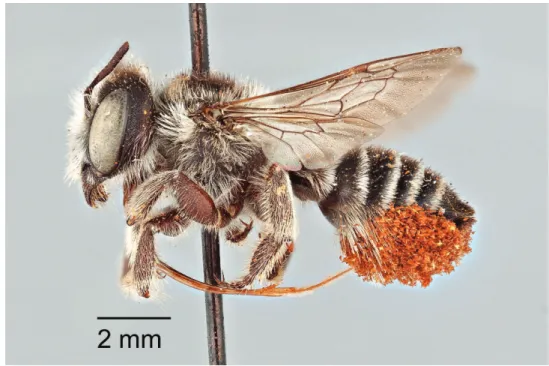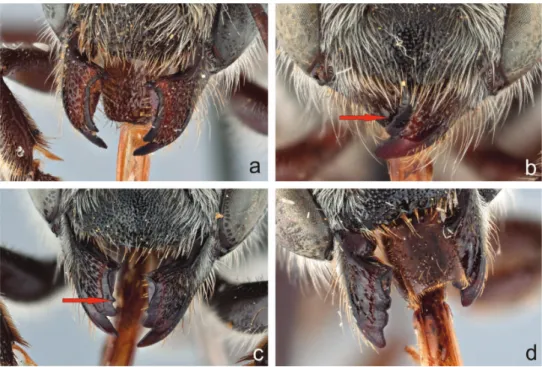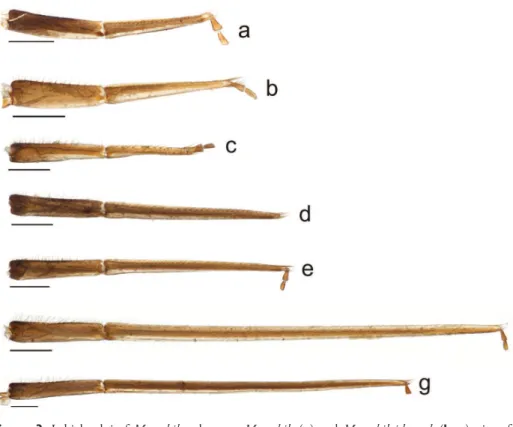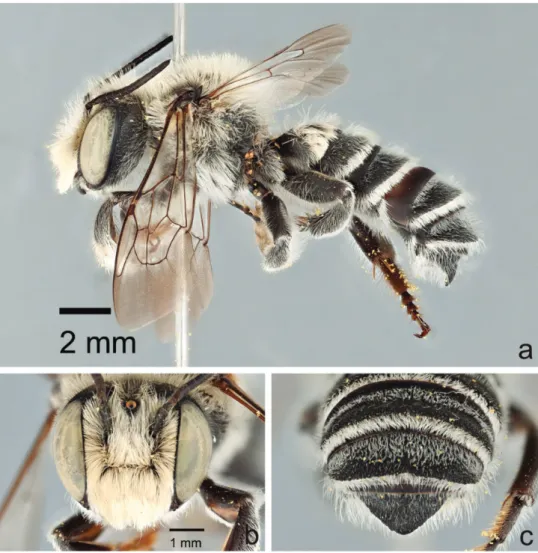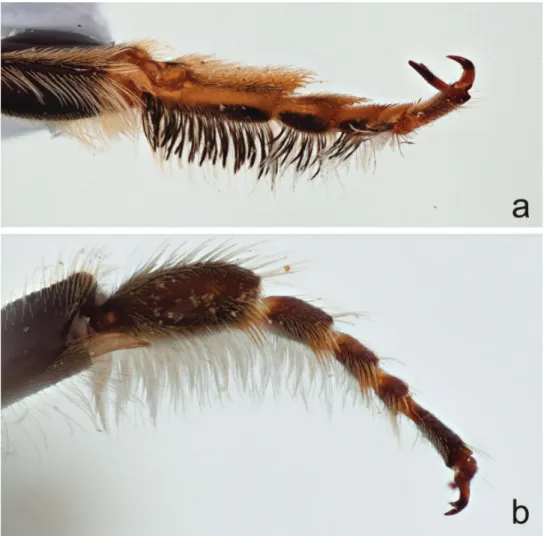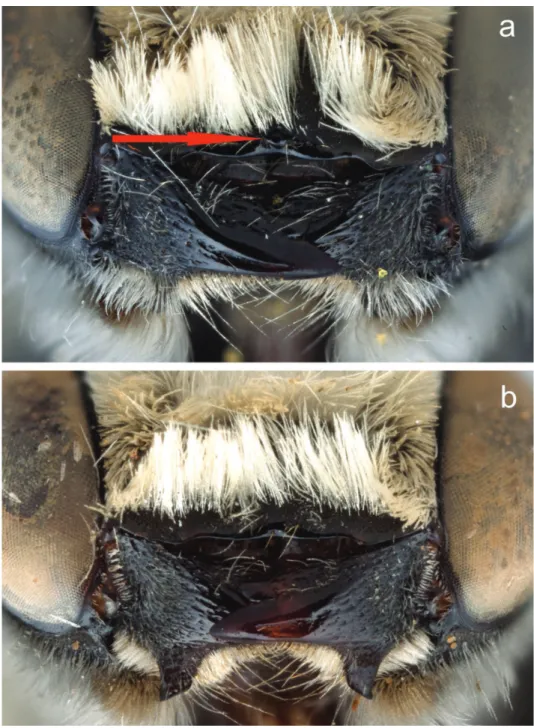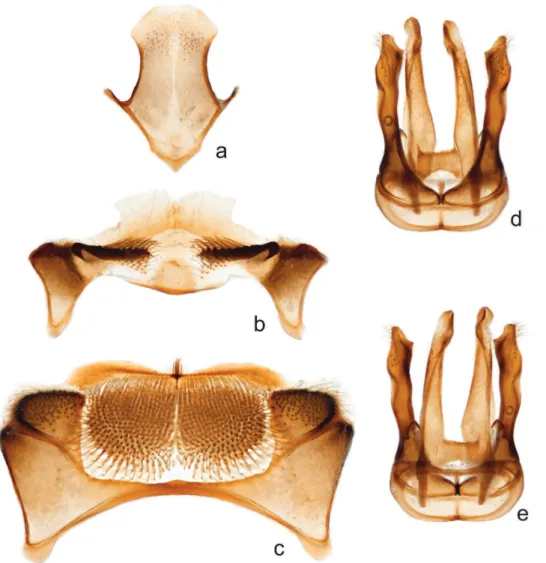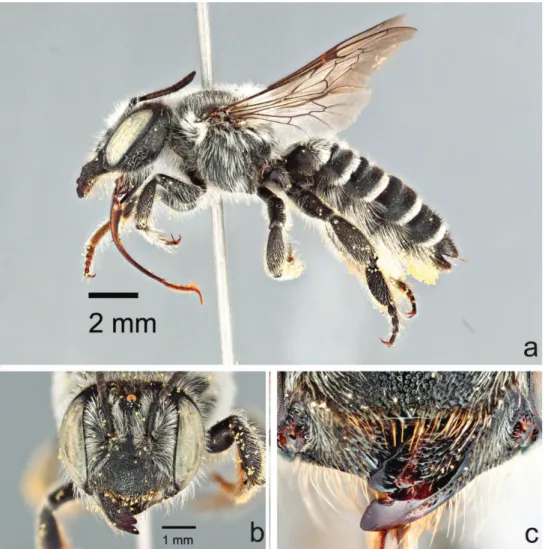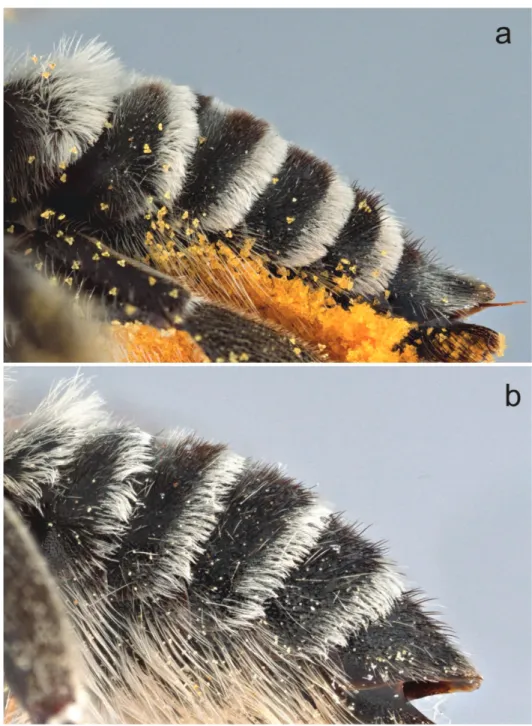A new species of Megachile Latreille subgenus Megachiloides (Hymenoptera, Megachilidae) 43
A new species of Megachile Latreille subgenus
Megachiloides (Hymenoptera, Megachilidae)
Cory S. Sheield1,†
1 Royal Saskatchewan Museum, 2340 Albert Street, Regina, Saskatchewan, Canada S4P 2V7
† urn:lsid:zoobank.org:author:E8A20492-60B0-411E-A119-99A6A7F16C15
Corresponding author: Cory S. Sheield (cory.sheield@gov.sk.ca)
Academic editor: M. Engel | Received 13 January 2013 | Accepted 6 March 2013 | Published 3 April 2013
urn:lsid:zoobank.org:pub:4019BA57-4516-4102-98A3-AFD721DA2C1E
Citation: Sheield CS (2013) A new species of Megachile Latreille subgenus Megachiloides (Hymenoptera, Megachilidae). ZooKeys 283: 43–58. doi: 10.3897/zookeys.283.4674
Abstract
A new species of leafcutter bee, Megachile (Megachiloides) chomskyi, is described from Texas, United States. Megachile chomskyi is one of the four known species of the oenotherae species group of Megachiloides, all members sharing the long tongue, and is most similar to M. (Megachiloides) amica Cresson. Like other members of the oenotherae species group, this species probably shows oligolecty with Onagraceae (Even-ing-Primrose Family). A diagnosis, full description of both sexes and a key to the species of the oenotherae species group are provided.
Keywords
Apoidea, Anthophila, Megachilinae, Onagraceae, Texas, Megachile chomskyi
Introduction
he subgenus Megachiloides Mitchell is the largest in North American Megachile La-treille, with just under 60 described species (Michener 2007; with recent synonymies in Sheield et al. 2011) ranging from southern Canada (Saskatchewan to British Colum-bia) to northern Mexico. Originally, Mitchell (1924) proposed the genus Megachiloides
to include one species, M. oenotherae Mitchell, which was morphologically distinct in possessing an extremely elongate tongue (i.e. glossum and labial palpus) (Figures 1 and 3f ), and by the characteristic 3-dentate mandible of the female, with a small
ZooKeys 283: 43–58 (2013) doi: 10.3897/zookeys.283.4674 www.zookeys.org
Copyright Cory S. Sheffield. This is an open access article distributed under the terms of the Creative Commons Attribution License 3.0 (CC-BY), which permits unrestricted use, distribution, and reproduction in any medium, provided the original author and source are credited.
ReseARCH ARtICLe
Launched to accelerate biodiversity research
Cory S. Sheield / ZooKeys 283: 43–58 (2013)
44
additional tooth that is scarcely distinguishable from the second within the elongate interspace (Figures 2b); Michener (2000, 2007) considers this a 4-dentate condition. Subsequently, the similar (Figure 2c), albeit larger species M. umatillensis Mitchell, was added to Megachiloides (Mitchell 1927). Mitchell (1934) later reduced Megachiloides to a subgenus of Megachile, and added M. amica Cresson, a species which also has a rela-tively elongate tongue (Figures 3d) and the characteristic mandibular structure, and ive additional species known at the time only from the female and possessing 3-den-tate mandibles without the small tooth in the second interspace (Figure 2a), but with tongues more typical to Megachile (Figure 3b). Mitchell (1934) also proposed the sub-genus Xeromegachile to include similar species with females with 4-dentate mandibles (Figure 2d) and short tongues (Figure 3c). Two years later, Mitchell (1936) proposed the subgenus Derotropis to separate the species with females with 3-dentate mandibles (Figure 2a) and short tongues (Figure 3b), and added several additional species, though only a few with males described and/or associated with females.
Subsequently, Mitchell (1980) reinstated Megachiloides to genus level; along with the subgenera Megachiloides, Derotropis, and Xeromegachile, he added Argyropile Mitch-ell and Phaenosarus Mitchell. his larger grouping thus contained all North American
Megachile with the carina of T6 of the male being entire, excluding, at that time, mem-bers of Argyropile (see Mitchell 1980), though males of a few species also share this character (see Gonzalez and Griswold 2007). his broader classiication thus also in-cluded females possessing 3-, 4-, and 5-dentate mandibles (Mitchell 1980). Michener (2000), not accepting Mitchell’s broad partitioning of Megachile (i.e. Mitchell 1980), reinstated Megachiloides to subgenus level and made Derotropis and Xeromegachile jun-ior synonyms; Argyropile recognized again as a subgenus, and Phaenosarus newly syn-onymized under subgenus Xanthosarus Robertson. hus, the subgenus Megachiloides s. l. contains females which are slightly less variable in mandible shape, Megachiloides s. str. (i.e. the oenotherae species group) considered an intermediate between the 3-den-tate Derotropis (Figure 2a) and the 4-dentate Xeromegachile (Figure 2d), with all males with the carina of T6 entire (Michener 2000).
he objective here is to describe a new species of Megachile from Texas, United States, and provide a diagnosis of this species and a key to distinguish it from oth-er memboth-ers of the oenotherae species group in North America. his work ultimately forms a contribution to an ongoing revision and phylogeny of Megachiloides s. l.
Methods
As part of previous work on Megachile in North America (Sheield and Westby 2007, Sheield et al. 2011), an ongoing revision and phylogeny of the subgenus
Megachil-oides s. l. (sensu Michener 2000), and a larger campaign to collect DNA barcodes
from all bees (Bee-BOL; Packer et al. 2009), representatives of many species of
Meg-achile were collected throughout North America and/or borrowed from other
A new species of Megachile Latreille subgenus Megachiloides (Hymenoptera, Megachilidae) 45
Nematodes (Ottawa, ON), the Packer Collection at York University (Toronto, ON), the Royal Saskatchewan Museum (Regina, SK), University of Alberta (Edmonton, AB) the Royal Alberta Museum (Edmonton, AB), Simon Fraser University (Vancou-ver, BC), USDA Bee Biology and Systematics Laboratory (Logan, UT), University of Kansas (Lawrence, KS), American Museum of Natural History (New York, NY), Central Texas Melittological Institute (Austin, TX), North Carolina State University Insect Museum (Raleigh, NC), Entomolgy Research Museum, University of Cali-fornia Riverside (Riverside, CA), and the USGS Patuxent Wildlife Research Center (Beltsville, MD).
Photomicrography was undertaken with a Canon EOS 5D Mark II digital camera with an MP-E 65 mm 1:2.8 1–5× macro lens. Measurements were made with an ocular micrometer on a Nikon SMZ1000 stereomicroscope. Head length was measured from the lower margin of the clypeus to vertex in facial view; tongue length was measured from the base of the prementum to the tip of the glossum. he following abbreviations are used in the descriptions: F, lagellomere; S, metasomal sternum; T, metasomal ter-gum; OD, median ocellar diameter; i=interspace; pd, puncture diameter. Morphologi-cal terminology generally follows Mitchell (1980) and Michener (2007).
systematics
Genus Megachile Latreille
Subgenus Megachiloides Mitchell
Megachiloides Mitchell, 1924: 154. Type species: Megachiloides oenotherae Mitchell, 1924, by original designation.
Megachile (Xeromegachile) Mitchell, 1934: 302, 309. Type species: Megachile integra
Cresson, by original designation.
Megachile (Derotropis) Mitchell, 1936: 156. Type species: Megachile pascoensis Mitch-ell, 1934, by original designation.
Megachile (Megachiloides) chomskyi Sheield, sp. n.
urn:lsid:zoobank.org:act:3A56D34A-E6FE-453E-BC9E-29A19613F75D http://species-id.net/wiki/Megachile_chomskyi
Specimen data at doi: 10.5886/txsd3at3
Figures 3e, 4, 5a, 6a, 7, 8, 9a
Holotype.♂ (Figure 4), 29707 // TEXAS: Winkler Co., 13.2 mi. E of 18 on rd 404,
Cory S. Sheield / ZooKeys 283: 43–58 (2013)
46
Allotype.♀, 29701 // TEXAS: Winkler Co., 13.2 mi. E of 18 on rd 404, 31.767°N,
102.824°W, 15-vi-2005, J. Nef & A. Hook // on lowers of Calylophus hartweggii
// Megachile amica Cresson ♀, det J.L. Nef 2005 // BeeBOL, CCDB-03768 A02,
BEECE002-10 [DNA barcode accession #s] // RSKM_ENT_E-0100328; deposited in the Royal Saskatchewan Museum, Regina, Saskatchewan, Canada.
Paratypes.♂ TEXAS: Ward Co., Monahans Sandhills State Park, campground
area, 31°38'12"N, 102°49'01"W 13 June 1998, C.R. Nelson #6733 & class //
Meg-achile amica♂, det. J. Nef 2005 // UTIC // RSKM_ENT_E-0100589; ♀, 31173 //
TEXAS: Ward Co., Monahans Sandhill S. P., 31.640°N, 102.819°W, J.L. Nef, 20-v-2006 // on lowers of Calylophus hartweggii // Megachile amica Cresson ♀, det J.L. Nef 2006 // BeeBOL, CCDB-03768 A04, BEECE004-10 [DNA barcode accession #s] // RSKM_ENT_E-0100591; 2♀, 29812, 29813 // TEXAS: Ward Co., Monahans Sandhill S. P., 31.640°N, 102.819°W, 16-vi-2005, J. Nef & A. Hook // on lowers of Calylophus hartweggii // Megachile amica Cresson ♀, det J.L. Nef 2005 // RSKM_ ENT_E-0100592, RSKM_ENT_E-0100593; ♀, TEXAS: Ward Co., Monahans San-dhill S. P., N31.640 W102.818, 16.VI.2005, elev 829m, A.W. Hook, J.L. Nef //
Megachile amica Cresson ♀, det J.L. Nef 2005 // UTIC // RSKM_ENT_E-0100590;
♀, 29703 // TEXAS: Winkler Co., 13.2 mi. E of 18 on rd 404, 31.767°N, 102.824°W, 15-vi-2005, J. Nef & A. Hook // on lowers of Calylophus hartweggii // Megachile
amica Cresson ♀, det J.L. Nef 2005 // BeeBOL, CCDB-03768 A01, BEECE001-10
A new species of Megachile Latreille subgenus Megachiloides (Hymenoptera, Megachilidae) 47
29705 // TEXAS: Winkler Co., 13.2 mi. E of 18 on rd 404, 31.767° N; 102.824° W, 15-vi-2005, J. Nef & A. Hook // on lowers of Calylophus hartweggii // Megachile
amica Cresson ♀, det J.L. Nef 2005 // RSKM_ENT_E-0100580-588; ♀, 21454 //
TEXAS: Kleberg Co., Sarita, 3 mi. N, 27°82.94"N, 97°47.92"W, 22-iv-2001, J.L. Nef // on lowers of Oenothera drummondii // Megachile amica Cresson ♀, det J.L. Nef // RSKM_ENT_E-0100594; ♀, May, Austin, Texas // Megachile amica Cresson
♀, det J.L. Nef 01 // UTIC // RSKM_ENT_E-0100595. Paratypes deposited in the Royal Saskatchewan Museum, the Central Texas Melittological Institute, the Univer-sity of Kansas, the USDA Bee Biology and Systematics Laboratory, and the American Museum of Natural History.
Diagnosis. he male of M. chomskyi can be distinguished by the combination of
Cory S. Sheield / ZooKeys 283: 43–58 (2013)
48
on the clypeal margin (Figure 6b). Male M. amica are typically smaller (10–12 mm), and have the carina of T6 less produced, with much dark pubescence on the apical terga, and S5 with postgradular area widely separated medially in basal half; males of
M. oenotherae and M. umatillensis lack the black plumose hairs on the front basitarsis (Figure 5b), M. oenotherae has darker front tarsi, and much dark pubescence on the mesoscutum and mesoscutellum.
In addition to also possessing a relatively long tongue with the second labial pal-pomere at least 1.7× the length of the irst (Figure 3e), the female of M. chomskyi
can be distinguished by the 3-dentate mandible, with a small vestige of a tooth just posterior to the middle one, thus approaching a 4-tooth condition (Figure 8c), the relatively large size (13.5 mm), and the uniformly short dark hairs on T2-T4. It is also most similar to M. amica, M. oenotherae, and M. umatillensis. Females of M. amica are typically smaller (9-10 mm), and have dark hairs of varying length on T2-T4; females of M. oenotherae and M. umatillensis have an even longer tongue, the second labial palpomere at least 3× the length of the irst (Figures 3f and g).
A new species of Megachile Latreille subgenus Megachiloides (Hymenoptera, Megachilidae) 49
Description.Male: Body length 13 mm, forewing length 10 mm. Head width 4.3
mm; head length 3.9 mm (Figure 4b). Tongue length 7.2 mm, irst (i.e. basal) labial palpomere 0.55× length of second (Figure 3e). Intertegular distance 3.7 mm; distance between outer margins of tegulae 4.8 mm.
Structure. Compound eyes subparallel to slightly convergent below (Figure 4b).
Lateral ocelli slightly nearer to compound eye than to edge of vertex (5:6). Mandi-bles 3-dentate, lower process of mandible slender, acute, subbasal in position. Clypeal margin narrowly shiny and impunctate, broadly and shallowly emarginate with a dis-tinct median tubercle (Figure 6a). Gena as wide as compound eye in proile. F1 as long as broad, subequal in length to pedicel, slightly shorter than F2, F2 quadrate to very slightly longer than broad, F3-F8 longer than broad (2.5:2), apical segments Figure 4. Male Megachile (Megachiloides) chomskyi, new species (holotype). a lateral habitus b face
Cory S. Sheield / ZooKeys 283: 43–58 (2013)
50
A new species of Megachile Latreille subgenus Megachiloides (Hymenoptera, Megachilidae) 51
Cory S. Sheield / ZooKeys 283: 43–58 (2013)
52
setal patches rather widely divided, base of pregradular area slightly re-curved ventrally (several mites were found in the resulting cavity) (Figure 7b). S8 with lateral edges concave, apex rounded (Figure 7a). Gonocoxite sinuate in lateral view, with distinct ventral angle in basal third, narrowed basal to gonostylus region, ventral apical angle produced into small angular projection, dorsal apical surface covered with elongate hairs; penis valve relatively straight, slightly curved at tip and exceeding gonocoxite in length (Figures 7d and 7e).
Colour and pubescence. Integument black, tegula and apical tarsomere dark brown,
front femur yellowish-brown ventrally, basitarsus yellow on outer surface, becoming light brown along edges, reddish brown ventrally, tibial spurs yellowish-brown, T6 with me-Figure 7. Male Megachile (Megachiloides) chomskyi, new species (holotype); a sternum 8 b sternum 6
A new species of Megachile Latreille subgenus Megachiloides (Hymenoptera, Megachilidae) 53
dian apical teeth reddish brown, apical edge of S4 broadly (i.e. 1.5 OD) hyaline. Wings clear, faintly hyaline apically beyond veins, veins dark brown. Pubescence entirely pale yellowish-white on body, becoming somewhat paler to white on mesosoma ventrally, dense and entirely pale yellow on face below level of median ocellus, mesoscutum rather sparsely but uniformly pubescent, becoming slightly longer and denser at periphery and on scutellum, terga with mostly pale yellowish-white pubescence, long and rather dense on T1, sparser but long and suberect on T2, erect hairs becoming sparser on T3-T5, basal groove of T3 and T4 with narrow band of white tomentum, more extensive on T5 (Figure 4c), T6 thinly pale pubescent above carina, with elongate plumose hairs later-ally and below carina, T2-T5 with dense white apical fascia; front basitarsus with row of elongate black densely plumose hairs beneath white fringe of hairs (Figure 5a).
Figure 8. Female Megachile (Megachiloides) chomskyi, new species (paratype). a lateral habitus b face
Cory S. Sheield / ZooKeys 283: 43–58 (2013)
54
Surface sculpture. Punctures ine and close on face, somewhat shallow but distinct
on gena, becoming deeper but rather ine and close (<1pd) on vertex medially, more irregular sized but still close on vertex laterally, ine and very close on clypeus and on Figure 9. Metasomal terga of female aMegachile (Megachiloides) chomskyi, new species (paratype), and
A new species of Megachile Latreille subgenus Megachiloides (Hymenoptera, Megachilidae) 55
supraclypeal area, apical edge of clypeus narrowly shiny and impunctate, mesoscutum and mesoscutellum with punctures shallow but distinct, rather ine and uniformly close, surface dull, punctures becoming deeper on pleura below, tegula inely and closely punc-tate throughout, propodeum with shallow, ine punctures with i=0.5-1pd, triangle dull, smooth and impunctate, punctures ine over most of dorsal surface of metasoma, minute and very close on T2, larger but still close (i<1pd) on T3, larger on T4 with shiny i=1pd, larger and somewhat elongate on apical 1/3 of T5, ine and densely crowded on T6, coarse and close (i=1pd) on S1-S2, becoming sparser (i=3-4pd) in apical half of S3-S4.
Female: Body length 13–13.5 mm, forewing length 8.5 mm. Head width 4.0 mm;
head length 3.3 mm (Figure 8b). Tongue length 7.2 mm, irst (i.e. basal) labial palp 0.55× length of second (Figure 3e). Intertegular distance 3.3 mm; distance between outer margins of tegulae 4.2 mm.
Structure. Compound eyes very slightly convergent below (Figure 8b). Lateral
ocelli as near to compound eye as to edge of vertex. Mandible 3-dentate, two apical teeth approximate, with small angle interrupting long cutting edge between 2nd and
in-ner teeth (Figure 8c). Clypeal margin smooth, very slightly produced in median third. Gena as wide as compound eye in proile. F1 as long as broad, and subequal in length to pedicel, longer than F2, F2 broader than long (1.5: 1.2), F3-F9 quadrate to slightly longer than broad, apical lagellomere more elongate (2.5:1.5). T2-T5 with shallow but distinct grooves across base, graduli carinate, apical margins slightly depressed, laterally only on T2. T6 very slightly concave in proile.
Colour and pubescence. Integument black, lagellum and tegula dark brown,
tibial spurs yellow-brown. Wings clear, faintly hyaline apically beyond veins, veins dark brown. Pubescence mostly white on body, a few short dark hairs on vertex later-ally, in apical half of T2 (basal to fasciae), more extensive on T3, occupying almost entire surface of T4 and T5 (Figure 9a), T6 with short, thick, black pubescence inter-spersed with thin, pale, longer hairs. S2-S5 with scopa white, black on S6, pale hairs sparse on clypeus and supraclypeal area, becoming denser and longer on face around bases of antennae, mesoscutum sparsely pubescent, with short erect hairs, more dense at periphery, more elongate on mesoscutellum and pleura.
Surface sculpture. Punctures ine and close on face, rather shallow on gena with
Cory S. Sheield / ZooKeys 283: 43–58 (2013)
56
Etymology. It is my pleasure to name this species after Professor Noam Chomsky,
Department of Linguistics & Philosophy at the Massachusetts Institute of Technology (MIT) for his many academic achievements and contributions as a linguist, philoso-pher, cognitive scientist, historian, political critic, activist and global champion of hu-man rights and freedoms.
Distribution.Megachile chomskyi is known from the state of Texas, United States.
Discussion
Megachile chomskyi is morphologically very similar to M. amica, but difers from
that species not only in a series of structural characters, but also in COI similarity by 7.8%; intraspeciic variation for each species averaging less than 0.8% (n=3) (unpublished). he subgenus Megachiloides still remains one of the most problem-atic Megachile groups in North America, due in part to the large proportion of species described from one sex (Sheield and Westby 2007), outdated keys and descriptions which are poorly illustrated. Sheield et al. (2011) associated some of the sexes, and with the assistance of DNA barcoding, discovered that several of the species occur as melanistic forms previous recognized as valid species known only from the female. he relationship of Megachiloides with other subgenera is also still not resolved (Gonzalez 2008), though a phylogeny and full revision of the subgenus are forthcoming.
As is suspected for other members of the oenotherae species group of
Meg-achiloides, M. chomskyi may be a loral specialist of Onagraceae (Evening-Primrose
Family). Most of the specimens examined were collected on Calylophus hartweg-gii (Benth.) P.H. Raven., which also occurs in Arizona, Colorado, Kansas, New Mexico, and Oklahoma, and Oenothera drummondii Hook., which occurs in Texas, Florida, Louisiana, North and South Carolina. herefore, it is possible that some specimens presently identiied as M. amica, which ranges from Arizona, north to Kansas and southeast to Texas, are actually this species. In Texas, M. chomskyi has been collected from late April to June.
Key to the oenotherae species group of Megachiloides
Females
1 Tongue relatively short, extended length of glossum not reaching beyond mid length of metasoma (Figure 8a), second labial palpomere less than twice the length of the basal palpomere (Figures 3d and 3e) ...2
A new species of Megachile Latreille subgenus Megachiloides (Hymenoptera, Megachilidae) 57
2 Larger (13.5 mm), dark pubescence of T2 and T3 uniformly short and dense, maximum length less than half of width of pale apical fascia (Figure 9a) ... ...M. chomskyi sp. n.
– Smaller (≤11 mm), dark pubescence of T2 and T3 of intermixed length, length of longer, coarser dark hairs approaching width of apical fascia (Figure 9b) ...M. amica Cresson
3 Larger (≥13 mm); pubescence on mesonotum entirely pale ... ...M. umatillensis (Mitchell)
– Smaller (11 mm); pubescence on mesoscutum and mesoscutellum with much black pubescence ...M. oenotherae (Mitchell)
Males
1 Fringe of front basitarsus with distinct ventral row of elongate, black densely plumose hairs (Figure 5a)...2
– Fringe of front basitarsus entirely white, lacking black hairs (Figure 5b) ...3
2 Larger (13 mm); clypeal margin shallowly emarginate, with small median tubercle (Figure 6a); carina of tergum 6 more produced, narrowly triangular; apical terga with pubescence almost entirely pale, tergum 5 with rather dense pale tomentum in basal half (Figure 4c) ...M. chomskyi sp. n.
– Smaller (10–12 mm); clypeal margin straight, lacking median tubercle (Fig-ure 6b); carina of tergum 6 broadly rounded; apical terga with much black pubescence, tergum 5 lacking pale tomentum ...M. amica Cresson
3 Larger (>13 mm); front basitarsus pale ...M. umatillensis (Mitchell)
– Smaller (9–10 mm); front basitarsus mostly dark ....M. oenotherae (Mitchell)
Acknowledgements
Cory S. Sheield / ZooKeys 283: 43–58 (2013)
58
References
Gonzalez VH (2008) Phylogeny and Classiication of the Bee Tribe Megachilini (Hymenop-tera: Apoidea, Megachilidae), with Emphasis on the Genus Megachile. PhD thesis, Law-rence, Kansas: University of Kansas.
Gonzalez VH, Griswold TL (2007) A review of the North and Central American Megachile
subgenus Argyropile Mitchell (Hymenoptera: Megachildae). Zootaxa 1461: 1–14. www. mapress.com/zootaxa/list/2007/2007-04.html
Michener CD (2000) he Bees of the World [1st Edition]. Johns Hopkins University Press, Baltimore, MD, xiv+[i]+913 pp., +16 pls.
Michener CD (2007) he Bees of the World [2nd Edition]. Johns Hopkins University Press, Baltimore, MD, xvi+[i]+953 pp., +20 pls.
Mitchell TB (1924) New megachilid bees. Journal of the Elisha Mitchell Scientiic Society 40: 154–165.
Mitchell TB (1927) New megachilid bees. Psyche 34: 104-121. http://psyche.entclub. org/34/34-104.html
Mitchell TB (1934) A revision of the genus Megachile in the Nearctic region. Part I. Clas-siication and descriptions of new species (Hymenoptera: Megachilidae). Transactions of the American Entomological Society 59: 295–361; plates xx-xxi. http://www.jstor.org/ stable/25077304
Mitchell TB (1936) A revision of the genus Megachile in the Nearctic region. Part IV. Taxon-omy of the subgenera Xanthosarus, Phaenosarus, Megachiloides and Derotropis (Hymenop-tera: Megachilidae). Transactions of the American Entomological Society 62: 117–166; plates viii-xi. http://www.jstor.org/stable/25077371
Mitchell TB (1980) A Generic Revision of the Megachiline Bees of the Western Hemisphere. Contributions from the Department of Entomology. North Carolina State University Graphics, Raleigh, NC 95 pp.
Packer L, Sheield CS, Gibbs J, de Silva N, Best LR, Ascher J, Ayala R, Martins D, Roberts SPM, Tadauchi O, Kuhlmann M, Williams PH, Eardley C, Droege S, Levchenko TV (2009) he campaign to barcode the bees of the world: progress, problems, prognosis. In: Yurrita CL (Ed) Memorias VI Congreso Mesoamericano sobre Abejas Nativas. Antigua, Guatemala, pp. 178–180.
Sheield CS, Westby SM (2007) he male of Megachile nivalis Friese, with an updated key to members of the subgenus Megachile s. str. (Hymenoptera: Megachilidae) in North Ameri-ca. Journal of Hymenoptera Research 16: 178–191. http://biostor.org/reference/383 Sheield CS, Ratti C, Packer L, Griswold T (2011) Leafcutter and mason bees of the genus
